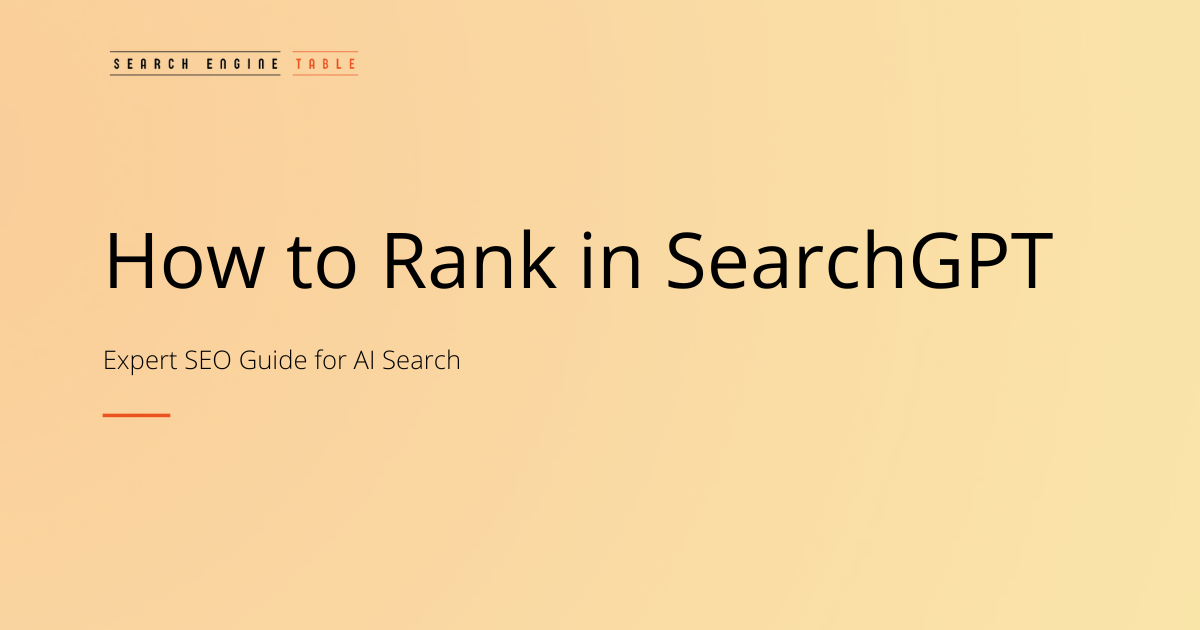The digital marketing landscape is rapidly evolving, and one of the most significant shifts on the horizon is the rise of AI-powered search engines like SearchGPT. As traditional search engines like Google have dominated the web for years, the introduction of SearchGPT by OpenAI offers a new paradigm in how search results are generated, ranked, and delivered.
This shift presents both a challenge and an opportunity for businesses, content creators, and SEO specialists to rethink their approach to SEO.
This guide will break down the core concepts of SearchGPT SEO, offering actionable strategies for adapting your content to this new search engine and ensuring your website is optimized for AI-powered search.
How SearchGPT is Changing the SEO Game
Before diving into strategies, it’s essential to understand what SearchGPT is and how it differs from traditional search engines.
What is SearchGPT?
SearchGPT is an AI-driven search engine that generates answers based on real-time, high-quality data. Rather than crawling and indexing websites in the traditional sense like Google, SearchGPT uses advanced Natural Language Processing (NLP) algorithms to interpret user queries and generate responses in a conversational format.
The system relies on vast amounts of data, machine learning, and conversational AI to understand search intent and deliver accurate, contextually relevant answers.
Unlike traditional search engines, where results are primarily ranked by keywords, backlinks, and other signals, SearchGPT focuses on providing direct answers to queries, often without users needing to click through to a website.
This makes the approach to SEO significantly different from what marketers are used to.
How Does SearchGPT Work?
SearchGPT combines multiple elements to deliver highly relevant results:
- Real-Time Data: Unlike traditional search engines, SearchGPT pulls from real-time data to provide answers that reflect the most current information available.
- Conversational Interaction: It is designed to interpret and respond to queries in a conversational manner, allowing for follow-up questions and deeper exploration.
- Clear Source Attribution: Unlike traditional search engines, SearchGPT emphasizes providing clear source links to where the information originates. This increases transparency and ensures that users are directed to trusted sources.
- Real-time Answer Generation: SearchGPT generates answers instantly, ensuring that users are provided with direct solutions, often removing the need to click through to other websites.
Understanding these core elements helps businesses and content creators strategize how to adapt their SEO efforts to fit SearchGPT’s unique requirements.
Who Should Optimize for SearchGPT SEO?

Target Audience Demographics and Needs:
The impact of SearchGPT is felt across various industries, and understanding the target audience is key to crafting successful SEO strategies for this platform.
The primary users likely to benefit from SearchGPT SEO are:
- Content Creators & Bloggers: Individuals who regularly publish content and aim to drive traffic to their websites should tailor their SEO strategies to focus on answering conversational queries and offering high-quality, factual content.
- E-commerce Businesses: Online stores that want to increase visibility for their products on AI-powered search engines need to adopt techniques that optimize for AI search intent and real-time data.
- Healthcare, Education, and Knowledge-Based Sites: Websites offering health-related information, educational resources, or technical guides need to focus on presenting accurate, well-researched content that answers user questions directly.
- Publishers & News Websites: Media companies that publish news and updates should ensure that their content is easily discoverable through AI-driven search, emphasizing timeliness and accuracy.
- Tech and SaaS Companies: Tech companies or SaaS platforms that constantly innovate and release new updates need to provide quick, easily understandable content about their products and services, which aligns with SearchGPT’s strengths in real-time data.
Businesses can gain a competitive edge by aligning content with the needs of SearchGPT’s algorithms.
How to Rank in SearchGPT: Key Strategies for Success
The core of SearchGPT SEO revolves around delivering high-quality content in a conversational, context-aware manner.
Here are some of the key strategies businesses can implement to rank effectively on SearchGPT:
1. Optimize Content for Search Intent
SearchGPT thrives on understanding user intent, which is why focusing on the types of questions your audience is asking is essential. Marketers must ensure their content addresses users’ specific needs and queries.
Consider these common types of search intent:
- Informational: Users are looking for answers to questions or general knowledge (e.g., “What is SearchGPT?” or “How does AI search work?”).
- Transactional: Users are looking to purchase or take action on a product or service (e.g., “Buy AI-powered content creation tools”).
- Navigational: Users are looking for specific websites or pages (e.g., “Visit OpenAI’s SearchGPT page”).
When crafting content, structure it around answering these different types of search queries, ensuring that it aligns with the language and context SearchGPT uses to understand user needs.
Also, check out this article: Is your job at risk of being replaced by ChatGPT?
2. Create High-Quality, Fact-Based Content
SearchGPT emphasizes accuracy. Factual, well-researched, and updated content will perform better on SearchGPT. This means content must be written well and regularly updated to reflect the latest trends, information, and developments.
- Use credible sources: Your content should be supported by authoritative references. To boost the credibility of your content, cite studies, statistics, and research that are well-regarded in your industry.
- Update regularly: Keep your content current with the latest industry news, trends, and developments to increase its likelihood of ranking for real-time queries.
3. Write in a Conversational Tone
SearchGPT is optimized for natural language processing, meaning it understands and responds to queries in a conversational tone. To rank well in SearchGPT, write content miming how people naturally speak and ask questions.
- Use question-based headings: As SearchGPT prioritizes queries that come in the form of questions, use headings like:
- “How do AI search engines work?”
- “Why is SearchGPT different from Google?”
- Focus on long-tail keywords: These keywords are often more conversational and specific. By targeting long-tail, question-based phrases, your content will more likely match SearchGPT’s query interpretation.
4. Incorporate Rich Media for Enhanced User Experience

Visuals, like images, infographics, and videos, can enhance the user experience and engagement.
While SearchGPT focuses on providing answers, content that includes rich media may still perform better overall because it keeps users engaged.
- Embed relevant images and videos: Adding multimedia elements can help break up text and keep visitors engaged.
- Interactive content: Consider using quizzes, polls, or interactive tools that provide users with personalized answers. These could align well with SearchGPT’s conversational nature.
5. Focus on Topic Clusters Rather Than Keywords
Traditional SEO often revolves around targeting individual keywords, but SearchGPT SEO benefits from a more holistic approach that revolves around topic clusters. Instead of writing isolated pieces of content based on individual keywords, create content around a broad topic and link to subtopics within it.
- Cluster content: For instance, a blog post titled “Complete Guide to AI Search Engines” can link to several subtopics like “How SearchGPT Works,” “Differences Between AI Search Engines,” or “How to Optimize for SearchGPT.”
By covering a range of subtopics within a central theme, you make your content more valuable and comprehensive, which SearchGPT favors.
6. Ensure Source Attribution and Transparency
SearchGPT favors content that cites reliable sources. Therefore, ensure that links to reputable, authoritative sources back up any factual claims you make. This could be academic papers, credible industry sources, or trusted websites.
- Cite sources: Whenever you mention statistics, studies, or facts, link directly to the sources. This builds trust and authority.
- Transparency: Be transparent about where your data and information come from. Trustworthiness is crucial for ranking on SearchGPT.
7. User Engagement Signals Matter
Although SearchGPT is AI-powered, it still considers user engagement as a ranking factor. If users find your content valuable, they are more likely to interact with it, share it, and engage with it in various ways.
- Encourage comments: If your platform allows it, enable comments so users can engage with your content and add their own insights.
- Social media shares: Promote content across your social channels to increase traffic and engagement, sending positive signals to SearchGPT.
Conclusion: The Future of SEO with SearchGPT
As the AI-driven search engine revolution continues to unfold, it’s essential to stay ahead of the curve. SearchGPT offers a new approach to SEO, one that requires marketers to focus on accuracy, conversational content, and real-time data. By shifting the focus from traditional SEO practices to those that align with AI’s capabilities, businesses can maintain their visibility and relevance in an ever-changing digital environment.
To succeed in SearchGPT SEO, it’s crucial to produce high-quality, well-researched content, optimize for natural language queries, update content regularly, and focus on user engagement. With these strategies in place, your website will be well-positioned to thrive in the age of AI-driven search.
Incorporating these practices will ensure that your content is not only discoverable but also relevant, trustworthy, and valuable to your target audience.
The future of SEO is here, and AI powers it.
FAQs: Ranking on SearchGPT
SearchGPT is an AI-powered search engine developed by OpenAI, designed to provide conversational, real-time answers to user queries. Unlike traditional search engines that rank web pages based on keywords and backlinks, SearchGPT uses Natural Language Processing (NLP) to understand and generate contextually relevant answers directly from high-quality data sources.
To optimize for SearchGPT, create content that addresses specific user queries in a conversational, clear, and detailed manner. Use natural language and long-tail keywords, and focus on answering questions directly. Additionally, ensure your content is fact-based, regularly updated, and enriched with relevant images, videos, or infographics to improve engagement.
SearchGPT primarily values content accuracy, conversational relevance, and the quality of data sources. Unlike traditional SEO, it doesn’t rely as heavily on backlinks or keyword frequency but focuses more on delivering real-time, fact-driven answers that satisfy user intent.
SearchGPT uses AI and NLP to analyze user queries and determine their intent, which may be informational, transactional, or navigational. The system then generates responses that best match the user’s query type, providing immediate, relevant answers without requiring users to click through multiple search results.
Content that ranks well on SearchGPT is typically high-quality, informative, and conversational. It should address specific user questions or problems directly. Topics should be comprehensive and backed by credible sources. Ensuring your content is continuously updated to reflect the most accurate, real-time information is key to maintaining strong rankings.
Backlinks still hold some value in SearchGPT SEO, but they are not the primary ranking factor. Instead of focusing on accumulating backlinks, prioritize creating authoritative, fact-based content that answers users’ questions effectively. Transparent sourcing and high-quality writing are much more crucial.
While traditional SEO strategies like keyword optimization and backlinks are important, they need to be adapted for SearchGPT. Focus more on creating high-quality content that directly answers queries, uses natural language, and aligns with the search engine’s conversational model. Topic clusters, long-tail keywords, and conversational phrases are key to success.
Regularly updating your content is essential for ranking well in SearchGPT. Since the engine relies on real-time information, ensuring that your content reflects the latest trends, statistics, and developments will improve its relevance and ranking. Aim to refresh your content every few months or whenever significant updates occur in your industry.
Yes, like traditional search engines, SearchGPT favors mobile-friendly websites. A seamless user experience across mobile devices is important for retaining visitors and ensuring content ranks higher. Ensure your site is optimized for speed, usability, and responsive design.
Although SearchGPT does not directly rely on social media engagement as a ranking factor, increased social sharing can drive traffic to your site, which may indirectly influence your content’s visibility. Social media engagement can also serve as a sign of content quality and relevance, which SearchGPT values.
User experience plays a significant role in SearchGPT rankings. Content that is easy to read well-structured and engages users is favored. Features such as quick load times, intuitive navigation, and interactive elements like quizzes or polls can enhance user engagement, which is important for ranking well.
You can measure the effectiveness of your SearchGPT SEO efforts by monitoring organic traffic, engagement metrics like bounce rate and time on page, and ranking for long-tail, conversational keywords. Analyzing how well your content answers user queries and performs on AI-driven platforms is also a good indicator of SEO success.
Yes, local SEO is still important for SearchGPT, especially if you’re targeting region-specific queries. Optimizing your content with location-based keywords and creating Google My Business listings can help your website rank for location-based queries. However, always ensure your content delivers high-quality answers with local context to satisfy search intent.
To write effective content for SearchGPT, aim for clarity, conciseness, and relevance. Use a conversational tone, and focus on answering specific questions. Organize your content with clear headings, use bullet points for easy readability, and ensure your content is structured around user intent. Be sure to incorporate sources and include multimedia elements to enhance engagement.
AI tools can help streamline your SEO efforts for SearchGPT by analyzing search trends, optimizing for natural language queries, and providing content recommendations. Tools that focus on conversational AI and NLP can help you craft content that resonates with SearchGPT’s algorithms and ranks well for user queries.

